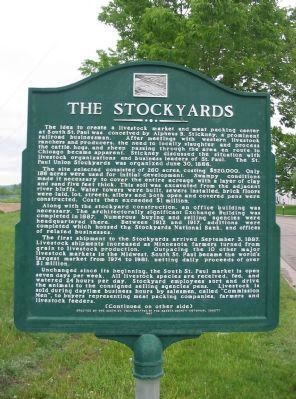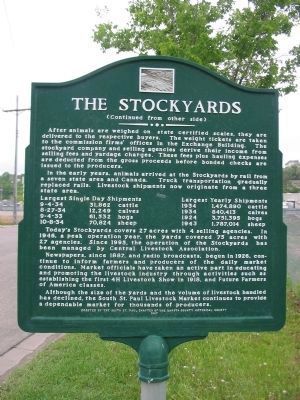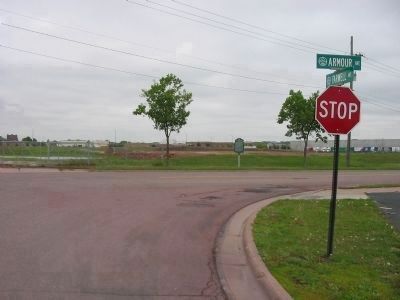South Saint Paul in Dakota County, Minnesota — The American Midwest (Upper Plains)
The Stockyards
The site selected consisted of 260 acres, costing $520,000. Only 186 acres were used for initial development. Swampy conditions made it necessary to cover the entire acreage with a layer of clay and sand five feet thick. This soil was excavated from the adjacent river bluffs. Water towers were built, sewers installed, brick floors were laid, lot, streets, alley and both open and covered pens were constructed. Costs then exceeded $1 million.
Along with the stockyard construction, an office building was necessary. The architecturally significant Exchange Building was completed in 1887. Numerous buying and selling agencies were headquartered there. Between 1912 and 1917, additions were completed which housed the Stockyards National Bank, and offices of related businesses.
The first shipment to the Stockyards arrived September 3, 1887. Livestock shipments increased as Minnesota farmers turned from grain to livestock production. Outpacing the 10 other major livestock markets in the Midwest, South St. Paul became the world’s largest market from 1974 to 1981, netting daily proceeds of over $1 million.
Unchanged since its beginning, the South St. Paul market is open seven days per week. All livestock species are received, fed, and watered 24 hours per day. Stockyard employees sort and drive the animals to the consigned selling agencies’ pens. Livestock is sold during daytime business hours by salesmen, called "Commission Men", to buyers representing meat packing companies, farmers and livestock feeders.
(Continued on other side)
(Continued from other side)
After animals are weighed on state certified scales, they are delivered to the respective buyers. The weight tickets are taken to the commission firms’ offices in the Exchange Building. The stockyard company and selling agencies derive their income from selling fees and yardage charges. These fees plus hauling expenses are deducted from the gross proceeds before bonded checks are issued to the producers.
In the early years, animals arrived at the Stockyards by rail from a seven state area and Canada. Truck transportation gradually replaced rails. Livestock shipments now originate from a three state area.
Largest Single Day Shipments
9-4-34 · 31,862 cattle
8-27-34 · 12,249 calves
9-4-33 · 61,532 hogs
10-8-34 · 70,824 sheep
Largest Yearly Shipments
1934 · 1,474,890 cattle
1934 · 840,413 calves
1924 · 3,751,395 hogs
1943 · 1,787,014 sheep
Today’s Stockyards covers 27 acres with 4 selling agencies. In 1946, a peak operation year, the yards covered 75 acres with 27 agencies. Since 1995, the operation of the Stockyards has been managed by Central Livestock Association.
Newspapers, since 1887, and radio broadcasts, begun in 1926, continue to inform farmers and producers of the daily market conditions. Market officials have taken an active part in educating and promoting the livestock industry through activities such as establishing the first 4H Livestock Show in 1918, and Future Farmers of America classes.
Although the size of the yards and the volume of livestock handled has declined, the South St. Paul Livestock Market continues to provide a dependable market for thousands of producers.
Erected 1997 by the South St. Paul Chapter of the Dakota County Historical Society.
Topics. This historical marker is listed in this topic list: Industry & Commerce. A significant historical date for this entry is June 30, 1759.
Location. 44° 53.153′ N, 93° 1.748′
W. Marker is in South Saint Paul, Minnesota, in Dakota County. Marker is at the intersection of Armour Avenue and Farwell Avenue on Armour Avenue. Touch for map. Marker is in this post office area: South Saint Paul MN 55075, United States of America. Touch for directions.
Other nearby markers. At least 8 other markers are within 4 miles of this marker, measured as the crow flies. Armour & Company (approx. ¼ mile away); Swift & Company (approx. 0.6 miles away); Kaposia Village (approx. 2.3 miles away); Kaposia: Dakota Village on the Mississippi River (approx. 2.4 miles away); The Salem Evangelical Church (approx. 2½ miles away); Battle Creek Regional Park (approx. 3.4 miles away); Holman Field (approx. 3.7 miles away); Charles W. Holman (approx. 3.7 miles away). Touch for a list and map of all markers in South Saint Paul.
Regarding The Stockyards. The facility closed April 11, 2008 and is now demolished.
Also see . . . The New York Times. "[April 11, 2008 was] the last day of auctioning at the stockyards of South St. Paul, Minn., which once were among the largest in the world but increasingly became an awkward presence in a major metropolitan area. New owners are planning to bulldoze everything to make room for light industry." (Submitted on May 29, 2010.)
Credits. This page was last revised on June 16, 2016. It was originally submitted on May 29, 2010, by Keith L of Wisconsin Rapids, Wisconsin. This page has been viewed 2,192 times since then and 113 times this year. Photos: 1, 2, 3. submitted on May 29, 2010, by Keith L of Wisconsin Rapids, Wisconsin. • Craig Swain was the editor who published this page.


